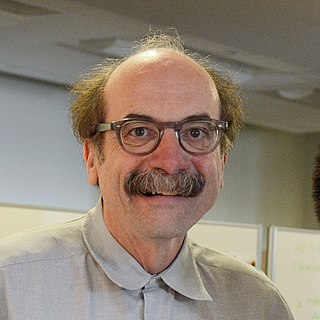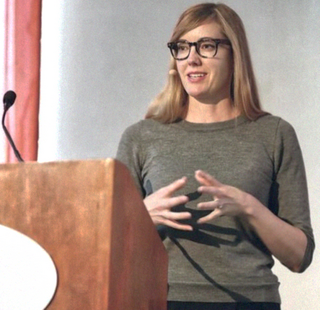Related Research Articles

Hasso Plattner is a German businessman. A co-founder of SAP SE software company, he has been chairman of the supervisory board of SAP SE since May 2003. As of August 2020, Forbes reported that he possessed a net worth of US$17.9 billion.

William Grant Moggridge, RDI was an English designer, author and educator who cofounded the design company IDEO and was director of Cooper Hewitt, Smithsonian Design Museum in New York. He was a pioneer in adopting a human-centred approach in design, and championed interaction design as a mainstream design discipline. Among his achievements, he designed the first laptop computer, the GRiD Compass, was honoured for Lifetime Achievement from the National Design Awards, and given the Prince Philip Designers Prize. He was quoted as saying, "If there is a simple, easy principle that binds everything I have done together, it is my interest in people and their relationship to things."

MIT World Peace University,(MIT-WPU) is a private university located in Kothrud, Pune, India. It is a part of the MIT Group of Institutions.

The University of Potsdam is a public university in Potsdam, capital of the state of Brandenburg, northeastern Germany.
Design thinking refers to the set of cognitive, strategic and practical procedures used by designers in the process of designing, and to the body of knowledge that has been developed about how people reason when engaging with design problems.
Edward Joseph McCluskey was a professor at Stanford University. He was a pioneer in the field of Electrical Engineering.
The Joint Program in Design was a graduate program jointly offered by the Department of Mechanical Engineering and the Department of Art & Art History at Stanford University. It was discontinued with the last cohort of students graduating in Spring 2017 and is succeeded by the Stanford Design Impact Engineering Master's Degree. The program offered degrees in Mechanical Engineering and in Fine Arts/Design and was closely connected with the Stanford d.school.

Christoph Meinel is a German computer scientist and professor of Internet technologies and systems at the Hasso Plattner Institute (HPI) of the University of Potsdam. In the years 2004 to 2023 he was the scientific director and CEO of the HPI and has developed the openHPI learning platform with more than 1 million enrolled learners. In 2019, he was appointed to the New Internet IPv6 Hall of Fame.

The Hasso Plattner Institute for Digital Engineering gGmbH is an information technology non-profit company affiliated with the University of Potsdam in Potsdam, Brandenburg, northeastern Germany.

The Segal Design Institute is a design thinking institute at Northwestern University. Segal operates within the McCormick School of Engineering and Applied Science and is dedicated to the study of human-centered design at the undergraduate and graduate level.

David M. Kelley is an American engineer, designer, businessman, and educator. He is co-founder of the design firm IDEO and a professor at Stanford University. He has received several honors for his contributions to design and design education.
Rolf A. Faste (1943–2003) was an American designer who made major contributions to the fields of human-centered design and design education. He is best known for his contributions to design thinking which he advanced as a 'whole person' approach to problem solving centered on the perception of needs. He was professor of industrial design at the Syracuse University from 1971 to 1983, and professor of mechanical engineering and director of the Stanford Joint Program in Design from 1984 to 2003.
The chain-linked model or Kline model of innovation was introduced by mechanical engineer Stephen J. Kline in 1985, and further described by Kline and economist Nathan Rosenberg in 1986. The chain-linked model is an attempt to describe complexities in the innovation process. The model is regarded as Kline's most significant contribution.
The Hasso Plattner Institute of Design at Stanford University is a design thinking institute based at Stanford University. The school is named after SAP co-founder Hasso Plattner and was founded by David M. Kelley and Bernard Roth founded the program in 2004.
Brian Witlin is an American businessman and fine artist. He is an entrepreneur who has co-founded tech companies including Leverworks, Shopwell, Golaces and has led Yummly as its CEO both before and after being acquired by Whirlpool in 2017. Witlin participates as a lecturer at Stanford University's Hasso Plattner Institute of Design.

Oyekunle Ayinde "Kunle" Olukotun is a British-born Nigerian computer scientist who is the Cadence Design Systems Professor of the Stanford School of Engineering, Professor of Electrical Engineering and Computer Science at Stanford University and the director of the Stanford Pervasive Parallelism Lab. Olukotun is known as the “father of the multi-core processor”, and the leader of the Stanford Hydra Chip Multiprocessor research project. Olukotun's achievements include designing the first general-purpose multi-core CPU, innovating single-chip multiprocessor and multi-threaded processor design, and pioneering multicore CPUs and GPUs, transactional memory technology and domain-specific languages programming models. Olukotun's research interests include computer architecture, parallel programming environments and scalable parallel systems, domain specific languages and high-level compilers.

Bio-inspired robotic locomotion is a fairly new subcategory of bio-inspired design. It is about learning concepts from nature and applying them to the design of real-world engineered systems. More specifically, this field is about making robots that are inspired by biological systems, including Biomimicry. Biomimicry is copying from nature while bio-inspired design is learning from nature and making a mechanism that is simpler and more effective than the system observed in nature. Biomimicry has led to the development of a different branch of robotics called soft robotics. The biological systems have been optimized for specific tasks according to their habitat. However, they are multifunctional and are not designed for only one specific functionality. Bio-inspired robotics is about studying biological systems, and looking for the mechanisms that may solve a problem in the engineering field. The designer should then try to simplify and enhance that mechanism for the specific task of interest. Bio-inspired roboticists are usually interested in biosensors, bioactuators, or biomaterials. Most of the robots have some type of locomotion system. Thus, in this article different modes of animal locomotion and few examples of the corresponding bio-inspired robots are introduced.
The University Innovation Fellows Program is an international innovation fellowship program for undergraduate and graduate students based at Stanford University. The UIF program was created in 2012.

Beth Ames Altringer is an American designer and academic in user-centered design and design education. She is the director of the Master of Arts in Design Engineering program at Brown University and the Rhode Island School of Design. Altringer previously ran the Design Lab at Harvard University and taught design and innovation at the Harvard John A. Paulson School of Engineering and Applied Sciences, Harvard Graduate School of Design, and Harvard Business School.
Allison Mariko Okamura is an American mechanical engineer and roboticist whose research concerns haptic technology, teleoperation, remote surgery, and robot-assisted surgery. She is the Richard W. Weiland Professor in the School of Engineering and a professor of mechanical engineering at Stanford University, where she directs the Collaborative Haptics and Robotics in Medicine (CHARM) laboratory and maintains a courtesy appointment as professor of computer science.
References
- ↑ Auernhammer, Jan; Roth, Bernard (16 August 2021). "The origin and evolution of Stanford University's design thinking: From product design to design thinking in innovation management". Journal of Product Innovation Management. 38 (6): 623–644. doi: 10.1111/jpim.12594 . Retrieved January 3, 2024.
- ↑ Leifer, Leifer (2005). "Center for Design Research, Stanford University". In: Clarkson, J., Eckert, C. (eds) Design process improvement. Springer. pp. 522–525. doi:10.1007/978-1-84628-061-0_35.
- ↑ "The Center for Design Research | Mechanical Engineering". me.stanford.edu. Retrieved 7 January 2024.
- ↑ "ME310 Design Innovation at Stanford University" . Retrieved 7 January 2023.
- ↑ Carleton, Tamara (27 August 2019). ME310 at Stanford University: 50 Years of Redesign (1967-2017). Innovation Leadership Publishing. ISBN 978-1733202206.
- ↑ Cockayne, William. "ME410 Strategic Foresight and Innovation". Stanford Foresight - Teaching. Retrieved 7 January 2023.
- ↑ Carleton, Tamara; Cockayne, William; Tahvanaine, Antti (1 January 2013). Playbook for Strategic Foresight and Innovation. Tekes. ISBN 978-9522655714.
- ↑ "Design Thinking Research Program" . Retrieved 7 January 2023.
- ↑ "Understanding Innovation" . Retrieved 7 January 2023.
- ↑ Pope, Morgan (16 Mar 2016). "Stanford's Flying, Perching SCAMP Robot Can Climb Straight Up Walls - SCAMP is a quadrotor with legs that can perch on walls and then climb up them with spiny little feet". IEEE Spectrum. IEEE. Retrieved 7 January 2024.
- ↑ Gent, Edd (21 Nov 2023). "Imagineer Morgan Pope Uses Electromagnetism to Spark Emotions. The Disney roboticist brings superheroes to life". IEEE Spectrum. IEEE. Retrieved 7 January 2024.
- ↑ Analytis, Santhi (2014). Technologies for needle manipulation in magnetic resonance image (MRI)-guided interventions (Thesis (Ph.D.)--Stanford University, 2014 thesis). Retrieved 17 January 2024.
- ↑ "Moxxly's Hands-Free Breast Pump Kit Is Legit Gonna Change The Way You Pump" . Retrieved 17 January 2024.
- ↑ "Meet Santhi Analytis, Our New Venture Fellow" . Retrieved 17 January 2024.